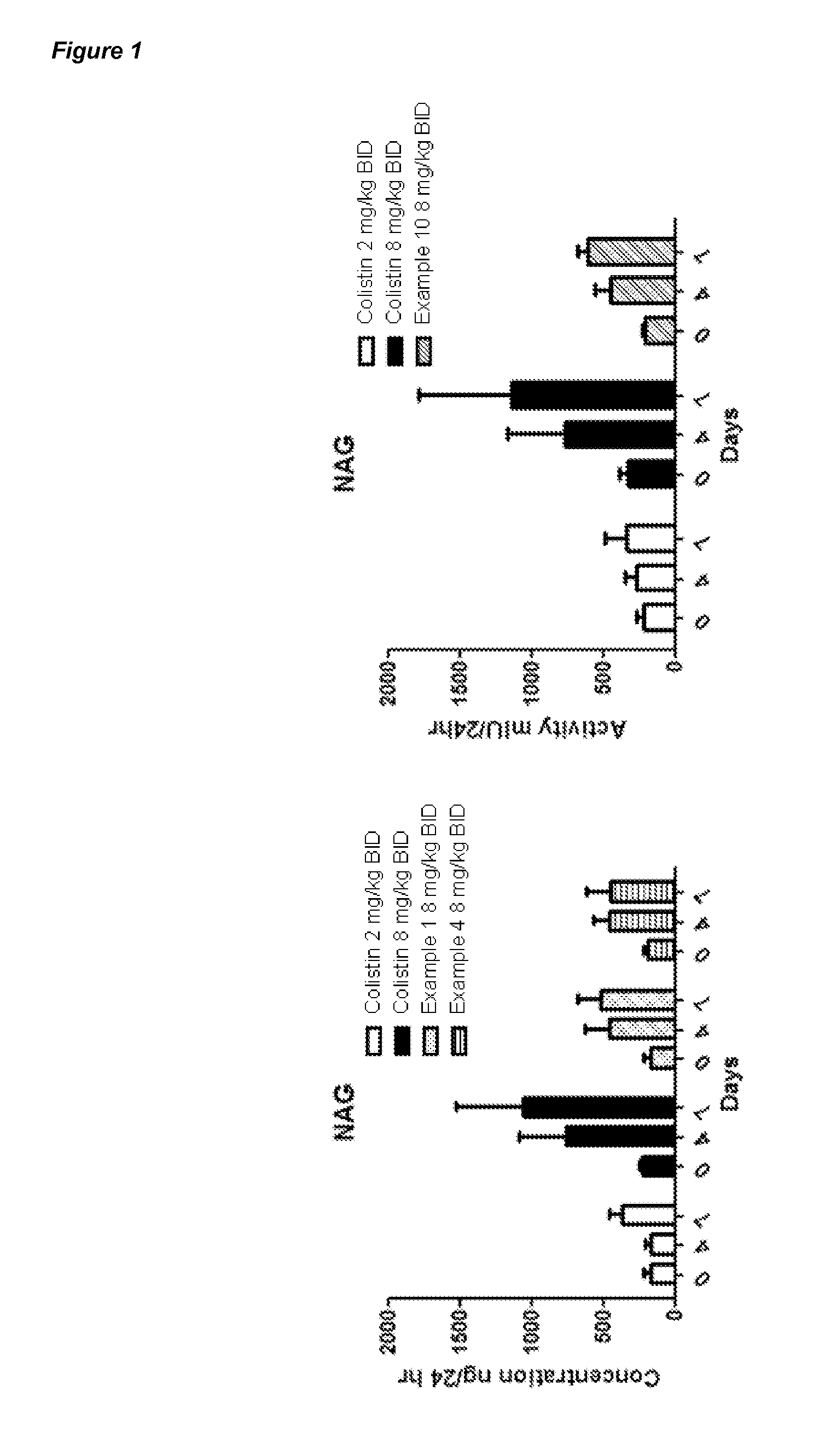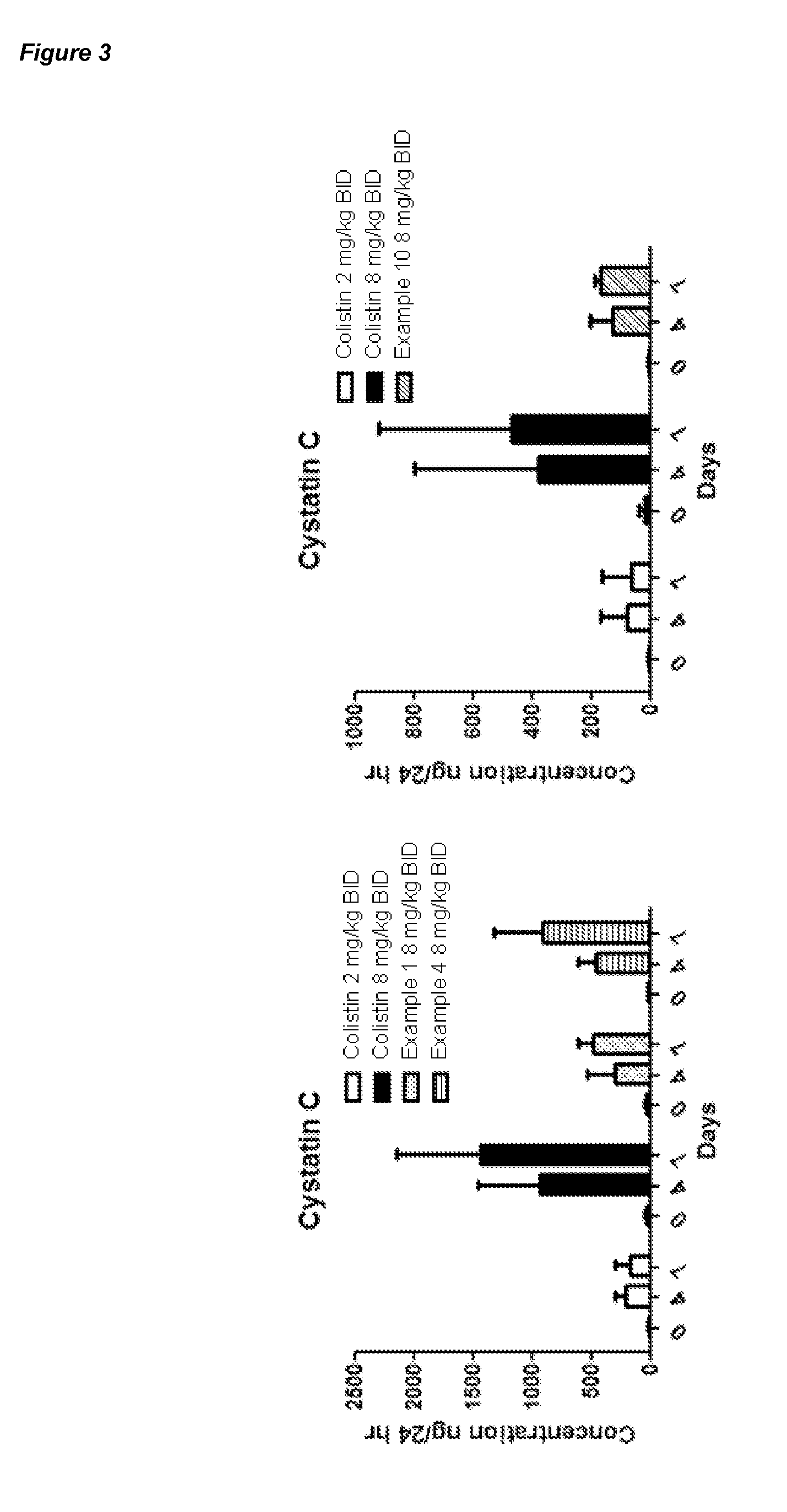Polymyxin Derivatives and Their Use in Combination Therapy Together with Different Antibiotics
a technology of polymyxin and derivatives, which is applied in the direction of antibacterial agents, drug compositions, peptide/protein ingredients, etc., can solve the problems of neurotoxicity and nephrotoxicity, antibiotic side effects, and complicated clinical practice treatment of serious bacterial infections
- Summary
- Abstract
- Description
- Claims
- Application Information
AI Technical Summary
Benefits of technology
Problems solved by technology
Method used
Image
Examples
examples
[0616]The following examples are provided solely to illustrate the present invention and are not intended to limit the scope of the invention, as described herein.
[0617]Nomenclature-Compounds are named based on the natural polymyxin core from which they are synthetically derived.
synthesis examples
Intermediate 1
Polymyxin B Nonapeptide
[0618]A mixture of EDTA (1.4 g), potassium chloride (1.1 g) and L-cysteine (0.12 g) was dissolved in water (475 mL) and potassium phosphate buffer (pH 7, 25 mL). The reaction was stirred at 37° C. for 10 min then Polymyxin B (10.3 g) was added. After stirring for 2 h at 37° C. papain (3.36 U / mg) was added and stirred for a further 18 h at 37° C. The progress of the reaction was monitored by LC-MS using the conditions outlined in Table 1. The crude material was separated into 87 mL fractions and purified using 10 g SCX cartridge (×6), eluting first with methanol (100 mL) and then 20% ammonia (aq, sp.g.880) in methanol (100 mL). The ammonia fractions were isolated and evaporated to give the product as beige solid, yield 4.95 g, 60% m / z 482, [M+2H]2+.
TABLE 1LC-MS conditionsMicromass Platform LCColumn:Zorbax 5μ C18 (2) 150 × 4.6 mmMobile Phase A:10% Acetonitrile in 90% Water, 0.15 %TFA or 0.1% formicMobile Phase B:90% Acetonitrile in 10% Water, 0.15 ...
example 49
N-[2-(1-aminocyclohexyl)ethyl] Polymyxin B nonapeptide
[0654]
[0655]Step 1—To a solution of Intermediate 2 (100 mg, 0.073 mmol) in methanol (1.5 mL) and DCM (1.5 mL) was added N-Boc-1-aminocyclohexyl acetaldehyde (Squarix GmbH) (21 mg, 1.2 equiv.), and glacial acetic acid (0.15 mL). The mixture was stirred at room temperature for 30 minutes. (Polystyrylmethyl)trimethylammonium cyanoborohydride (4.0 mmol / g, 100 mg, Novabiochem) was added and the mixture stirred at room temperature overnight. The resin was removed by filtration and the filtrate evaporated to dryness. The residue was chromatographed on silica eluting with 0-20% (10% 880 ammonia in Methanol) in DCM. The least polar component from the column corresponded to the BOC-protected bis-alkylated product, which was obtained as a white solid (30 mg, 23%). m / z 1814 (MH+). The most polar component corresponded to the BOC-protected title compound, (85 mg, 74%). m / z 1589 (MH+).
[0656]Step 2—The most polar component from step 1 (31 mg, 0...
PUM
| Property | Measurement | Unit |
|---|---|---|
| particle size | aaaaa | aaaaa |
| concentration | aaaaa | aaaaa |
| concentration | aaaaa | aaaaa |
Abstract
Description
Claims
Application Information
 Login to View More
Login to View More - R&D
- Intellectual Property
- Life Sciences
- Materials
- Tech Scout
- Unparalleled Data Quality
- Higher Quality Content
- 60% Fewer Hallucinations
Browse by: Latest US Patents, China's latest patents, Technical Efficacy Thesaurus, Application Domain, Technology Topic, Popular Technical Reports.
© 2025 PatSnap. All rights reserved.Legal|Privacy policy|Modern Slavery Act Transparency Statement|Sitemap|About US| Contact US: help@patsnap.com



